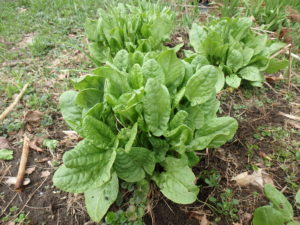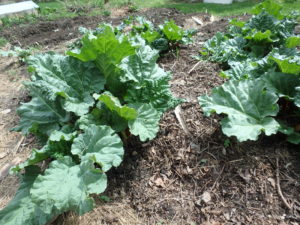Harvesting Now from the Vegetable Garden
It occurred to me as I walked up from my vegetable garden recently with a dozen fat parsnips, that gardening has something in common with fishing: you never know if you’re going to come home with something for dinner or not. Those parsnips, which were planted last summer, had spent the winter in the garden. Mice or voles might well have eaten them up – but they didn’t.
Parsnips, carrots and potatoes can spend the winter in the ground without injury –other than the risk of rodent damage. In fact, I leave most of my parsnips in the ground each fall because they taste sweeter in the spring. I mulched them well with straw in the fall.
Once the soil has dropped below 50 degrees F some of the carbohydrates turn to sugars. That’s why commercial potato growers store their spuds in temperature-controlled places that are above 50 degrees. MacDonalds and other big buyers of potatoes don’t want potatoes with high sugar content – they burn, or darken, when frying. So they carefully monitor temperatures, ensuing they stay a little above 50 degrees.
It’s not time to plant parsnip seeds yet, but I bought my seeds this week. Parsnip seeds are only good the year you bought them, so if you have left over seeds from last year, toss them out and buy new seeds.
Parsnip seeds take forever and a day to germinate – I have been known to wait a month to see them appear, even though the seed package might say they’ll start growing in 2 weeks. Wait until the soil warms up well before planting – late May or even early June is best.
Plant parsnip seeds half an inch deep and an inch apart in rows that are 6 inches apart. In a wide raised bed you can plant multiple short rows across the bed. Then, after your parsnips are a couple of inches tall, thin them to 3 to 4 inches apart. Even though they tend to grow straight down into the soil, they send tiny roots laterally and don’t like to be crowded.
If you are not familiar with parsnips, go to your local food co-op and buy a few and cook them up. After you’ve tasted them, you’ll know if you want to grow them or not. They are related to carrots, but have their own distinct flavor. You can steam or boil them like carrots, and serve with butter and a little hot maple syrup if you like.
Another recipe I like uses potatoes, parsnips and sorrel, an early-season green. Just peel and chop a pound of potatoes and 3/4 pound of parsnips; boil them until soft. Cut up a cup of sorrel and sauté in 2 ounces of butter until soft and mushy. Mash the root crops when cooked, add the sorrel and some heavy cream. Yum!
My sorrel is up now, and will be ready to harvest in early May. Sorrel is a great favorite of French cooks who make a soup with it. Although I grow it, I sometimes forget it’s there and overlook it. It’s a bright leafy green that comes back, year after year. It has a sharp lemony flavor, a bit like wood sorrel.
My problem with it is that when you cook it, it practically disappears. It has little substance. But it’s easy to grow, and adds a unique flavor if added to a salad or even a sandwich. Plants are often sold at garden centers in the herb section.
What else is coming up in the garden? Rhubarb. This sharp-flavored perennial stalk is a favorite of mine. Some varieties have deep red stems, others are green with just a hint of red. All will make you pucker up if you take a bite raw. The leaves contain oxalic acid, and are said to be poisonous.
I love rhubarb pie, strawberry-rhubarb pie, rhubarb sauce and rhubarb tea. You know the pies and sauce, I suppose, but the tea? It’s easy to make. Chop up a few stems and boil in an equal quantity of water. Once it gets mushy you can strain it and add more water and some sugar until you have a nice drink. I just use a little sugar – I like the tea plenty tart. I like to use red stems for the tea, as it looks so nice in a glass or cup. I drink it cold, too.
Chives are another perennial vegetable or herb. Mine are just up now and a couple of inches tall, despite the snow nearby in the same bed. This tasty fellow is best known as a garnish for baked potatoes, along with sour cream. It is one of the few things that will winter over easily in a pot on the kitchen window sill. But look for yours now, when there is little fresh in the garden to harvest.
I also grow garlic chives, but mine aren’t up yet. Garlic chives are bigger than chives and the flavor is bolder. I like them for their fuzzy white flowers that appear in early summer. The leaves are not hollow like chives, but flat. They are commonly used in Asian cooking. They’ll be along shortly.
I wish I had more perennial vegetables. Wouldn’t it be great if our tomatoes and squash came back like rhubarb, year after year?
Henry is a UNH Master Gardener and a gardening consultant. He is the author of 4 gardening books. His web site is www.Gardening-Guy.com.





